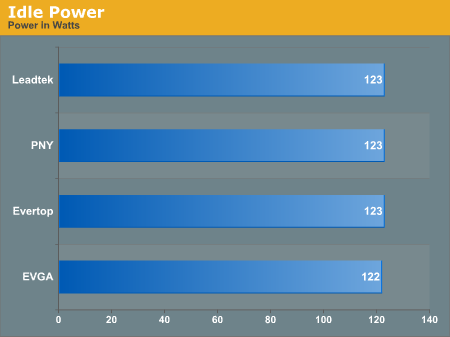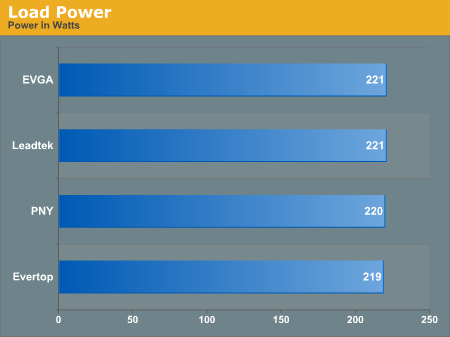The NVIDIA 6800 GS Closer Look: EVGA, Leadtek, PNY, and Evertop
by Josh Venning on January 27, 2006 8:53 AM EST- Posted in
- GPUs
Power, Heat and Noise
Power Load
To test the power load of the card, we measure the total watt usage of our test computer at the wall outlet, recording the power usage of our system in two different states. The first state is with the card installed and the computer is idle, and the second is during intensive performance tests (looped Splinter Cell benchmarks). This way, we are able to get a general idea of how the power usage varies between cards.
Heat
We also wanted to see how much heat these cards generated. We found that the EverTop 6800 GS generated the least amount of heat by a wide margin compared to the other three. The unique HSF design of this card may contribute to its low level of heat.
Noise
We were curious to see what kind of noise these cards generated as well. What is interesting here is that, similar to our heat tests, one card stood out among the rest. The EverTop GS was by far the most quiet of these cards, again perhaps due in part to the radical HSF design. The fact that it is the lowest clocked of these cards also plays a part here. The EverTop is the only card to use a non-reference HSF. Obviously, the Zalman fan, though bulky, does a better job of cooling the card while it keeps quiet. Below are the noise levels for each card.
For reference, the noise level of the room with the system off was 39.1.
Power Load
To test the power load of the card, we measure the total watt usage of our test computer at the wall outlet, recording the power usage of our system in two different states. The first state is with the card installed and the computer is idle, and the second is during intensive performance tests (looped Splinter Cell benchmarks). This way, we are able to get a general idea of how the power usage varies between cards.


Heat
We also wanted to see how much heat these cards generated. We found that the EverTop 6800 GS generated the least amount of heat by a wide margin compared to the other three. The unique HSF design of this card may contribute to its low level of heat.
| Graphics Card | Temperature |
| EverTop GeForce 6800 GS | 56 C |
| EVGA e-GeForce 6800 GS | 64 C |
| PNY GeForce 6800 GS Overclocked | 67 C |
| Leadtek WinFast PX6800 GS Extreme | 69 C |
Noise
We were curious to see what kind of noise these cards generated as well. What is interesting here is that, similar to our heat tests, one card stood out among the rest. The EverTop GS was by far the most quiet of these cards, again perhaps due in part to the radical HSF design. The fact that it is the lowest clocked of these cards also plays a part here. The EverTop is the only card to use a non-reference HSF. Obviously, the Zalman fan, though bulky, does a better job of cooling the card while it keeps quiet. Below are the noise levels for each card.
| Graphics Card | Noise Level |
| EverTop GeForce 6800 GS | 45.9 |
| PNY GeForce 6800 GS Overclocked | 50.1 |
| EVGA e-GeForce 6800 GS | 50.5 |
| Leadtek WinFast PX6800 GS Extreme | 50.7 |
For reference, the noise level of the room with the system off was 39.1.










56 Comments
View All Comments
bob661 - Friday, January 27, 2006 - link
....because AGP is dead. No need to mention it. LOL!JamesDax - Friday, January 27, 2006 - link
Gotta wonder why Nvidia and ATI are still releasing AGP cards then. Boggles the mind.DerekWilson - Friday, January 27, 2006 - link
Going forward, our focus will be on PCIe.But we could still have one or two things up our sleeves for those still working with AGP, so don't loose heart.
;-)
kmmatney - Friday, January 27, 2006 - link
Isn't AGP performance about the same?grizzly7 - Monday, January 30, 2006 - link
The AGP versions of 6800GS only have a core clock of 350MHz, so performance is worse.CuriousMike - Friday, January 27, 2006 - link
Honestly, this article did nothing but say, "Zalman makes a superior cooler."Better overclock, better cooling, and more quiet.
They're all ~ the same reference design (maybe different memory.)
Puddleglum - Friday, January 27, 2006 - link
Searched Newegg and found 4 eVGA 6800GS cards, and each one has different core clock speeds and memory speeds. http://www.newegg.com/Product/ProductCompare.asp?C...">Newegg search resultsIn the results, none of the cards are clocked at 450MHz/1.05GHz, and the fact that one of them comes factory set at 490MHz/1.1GHz makes me wonder if it can exceed the 510MHz/1.15GHz of your test card. An honest defense for eVGA regarding its nominal performance in this review is that you simply didn't use the right card.
DerekWilson - Friday, January 27, 2006 - link
Stock speeds are actually 425/1.0Meaning the EVGA is overclocked. They may have a more uber model out there, but this is the one they sent us when we mentioned this roundup to them.
From our experience with these cards, it seems like it would be difficult getting a 6800GS clocked higher than ~525 ... The EverTop card stayed cooler than the rest of them, so heat didn't really become a factor in preventing higher clock speeds. I just think the chip has the juice to get much faster than that.
Killrose - Friday, January 27, 2006 - link
Nice article, but the ATi X800GTO is well below the $200 price point. Forget Price Watch even, Newegg has some at the $130 mark and the 6800GS start at $189kmmatney - Friday, January 27, 2006 - link
Would have liked to have seen a X800GTO2 in there, as well as a 7800GT. The X800GTO2 can be had for $189, and unlocking the extra 4 pipes is easy and only has to be done once, ever. Out of the box, the 6800GS looks like a better deal, but the X800GTO2 gains more with overclocking/unlocking.